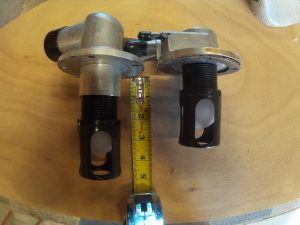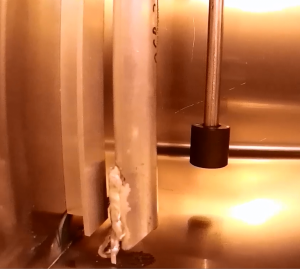You’ve heard about EPA compliant fuel systems and tanks. Heard the horror stories regarding portable tanks that blow up like a balloon until they reach five PSI. Since 1 Aug, 2013 all vessels sold in the US and using gasoline as a fuel have had to comply with the EPA Evaporative Emissions Regulations for Boat Fuel Systems. So what does that mean for your built in tank. Well quite a bit actually.
So the two ports pictured below are the end result of the modifications to metal tanks to make them compliant. The one on the left is the filler and the right is the vent. One big change you can see is the check valve ball and cage on both. The other is a two port vent assembly. When the fuel level comes up, the check ball closes off the fill and vent to prevent fuel spillage, spitback. Now the second and much smaller vent line is in place to handle diurnal and operational venting duties, through a charcoal canister.

This sounds super cool right? Our evil boats becoming more green and sustainable every day, but there is a downside to this. Take a look at how far down that check assembly extends into the tank. Just how much does this assembly reduce the tank volume?
Let’s do a bit of math to figure it out. Let’s assume that the ball (R=11/16) needs to be half submerged before it can cut off the inflow, and let’s take away the thickness of the tank skin. Check assembly protrudes 3.5” (This length varies with tank size) and tank skin is usually 1/8” – .1875”. Let’s also assume a 2’ x 4’ x 1’ tank (width x length x height).
3.5 – .125 – .6875 = 2.6875” fill height reduction from completely full tank.
2 x 4 x 1 = 8 cuft and 7.48 gals per cuft so our theoretical tank holds 8 x 7.48 = 59.84 gals.
Now here’s the part that hurts:
2.6875” x 2’ x 4’ = 1.79 cuft fill reduction for the check valve. 1.79 x 7.48 gals/cuft = 13.4 gals capacity reduction.
Now if you want to take a look at the video, you’ll see that the tank pickup is about 1 inch from the bottom. I didn’t stick a tape measure in there for a good reference, but that is a ½” pipe, so the outside diameter is .840. It gives a good reference to how far off the bottom the pickup will draw air. So now the usable fuel is reduced by another inch, although this is not epa driven, just sloppy in my opinion.

So another calculation.
1” x 2’ x 4’ = .6666… cuft or 4.98 unusable gallons.
So let sum this all up; 5 gals lost to the pickup and 13.4 gals lost to vapor space for a grand total of 18.4 gals of a 59.84 gallon tank that are unusable or 30% reduction or 41.44 usable.
So the next time you here a conversation about how you can only get 70 gallons into your 100 gallon tank you will know why and who to blame.